
|
|
Für die deutsche Fassung bitte nach unten scrollen
|
|
Invitation to the Exhibition Faces of the Past on 18 March in Vienna
|
|
|
|
We are delighted to invite you on 18 March at 7pm to our first major exhibition of the year in our showroom in Vienna. Under the title "Faces of the Past" we present over 20 ancient portraits made of marble and terracotta of famous personalities and ordinary pfrom antiquity. Portraits that corresponded to a beauty ideal 2,000 years ago and still do today in many cases.
|
|
As a preview for the exhibition, we introduce in this newsletter the life-size marble bust of a girl with the features of Fulvia Plautilla, the unfortunate wife of Caracalla. The magnificent portrait shows a young woman with chubby cheeks, but with a sublime and serious expression. A published portrait of Agrippina, mother of Nero and wife of Emperor Claudius, can also be seen for the first time on March 18. Another highlight is not least an outstanding female head from the Antonine period with elements of style from Crispina, the wife of the Emperor Commodus.
|
SAVE THE DATE. This and the following week you can already find us at WIKAM (from March 7th to 15th), the first major Viennese art fair of the year. Our booth with over 100 newly acquired ancient artworks is in the Festsaal of the splendid Palais Ferstl. We look forward to your visit!
|
|
|
|
|
|
Our Highlight of the Month:
|

|
|
|
|
|
|
Roman Empire – Severan Period, 193-235 A.D.
|
Magnificent marble portrait of a young woman, resembling to the well-known depiction of Fulvia Plautilla, wife of the later Emperor Caracalla. The girl slightly gazing to the right, with large eyes between thick lids, iris and pupils are worked out. The brows are worked into the stone. The chubby cheeks still very childish, though the expression already noble, with closed mouth and solemn features. Her hair pulled back in parallel streaks, thereby numerous details are worked out. At the back the hair is braided to a flat bun. The neck is slender and yet covered with soft lines. The head sits on an elaborately worked out bust from the 17th or 18th century. The nipples were once with metal pins, today marble ones are in place. The hairstyle, mouth and heavy lids resemble to the portraits attributed to Fulvia Plautilla, wife of the later Emperor Caracalla. Plautilla was banned after the annulation of their marriage. After Caracalla took up the reign he ordered his former wife to be killed. See for reference of a Plautilla portrait in the Archaeological Museum Naples with inventory number 6189.
|
Provenance: Private collection of the 17th-18th century, based on the plinth. Thence in the private collection of a French composer, acquired in the 1940s. Bonhams auction London of 5 October 2001, lot 137.
Dimensions: 60 cm high
Price: 38 000 Euro
|
|
|
|
Selected Artworks of the Month:
|
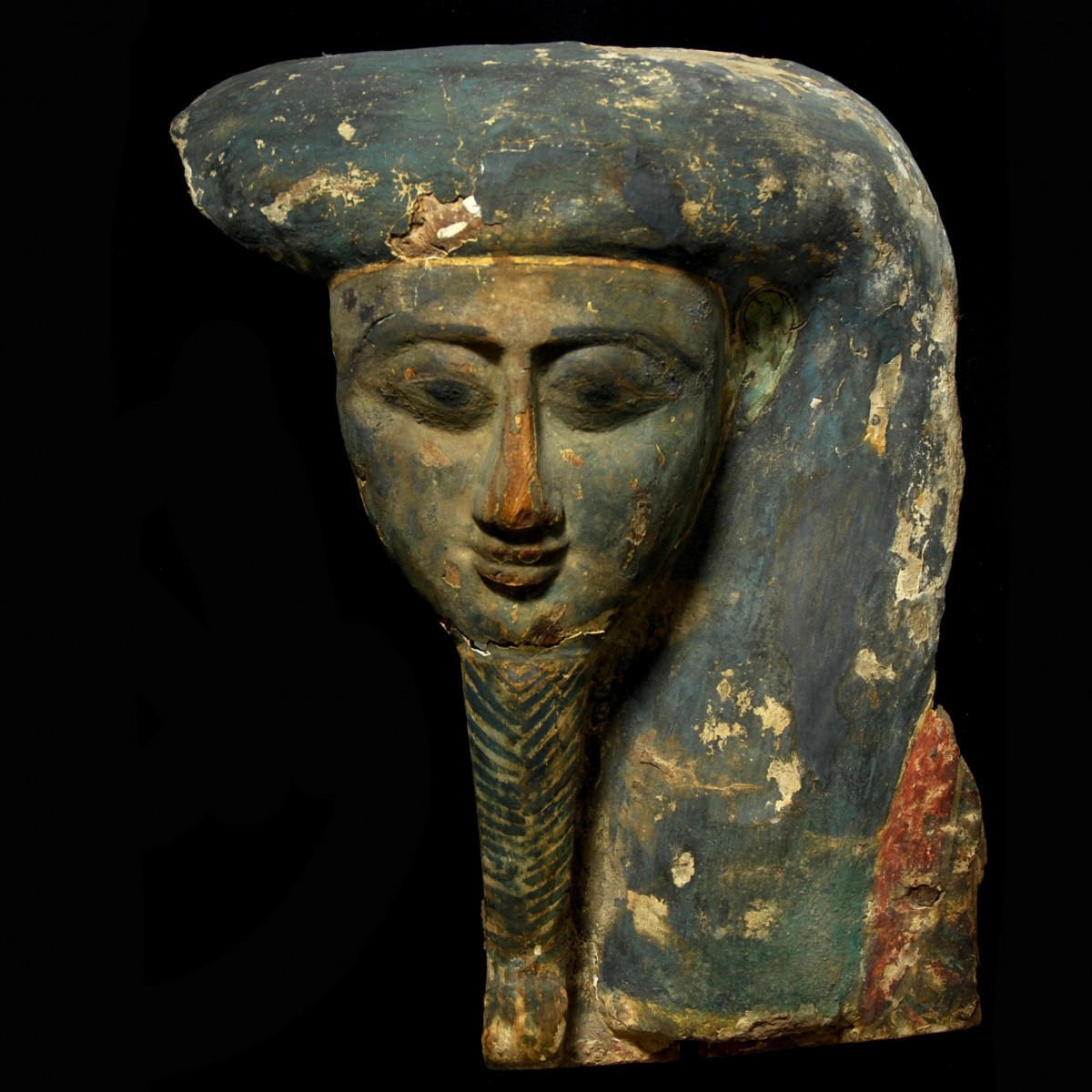
|
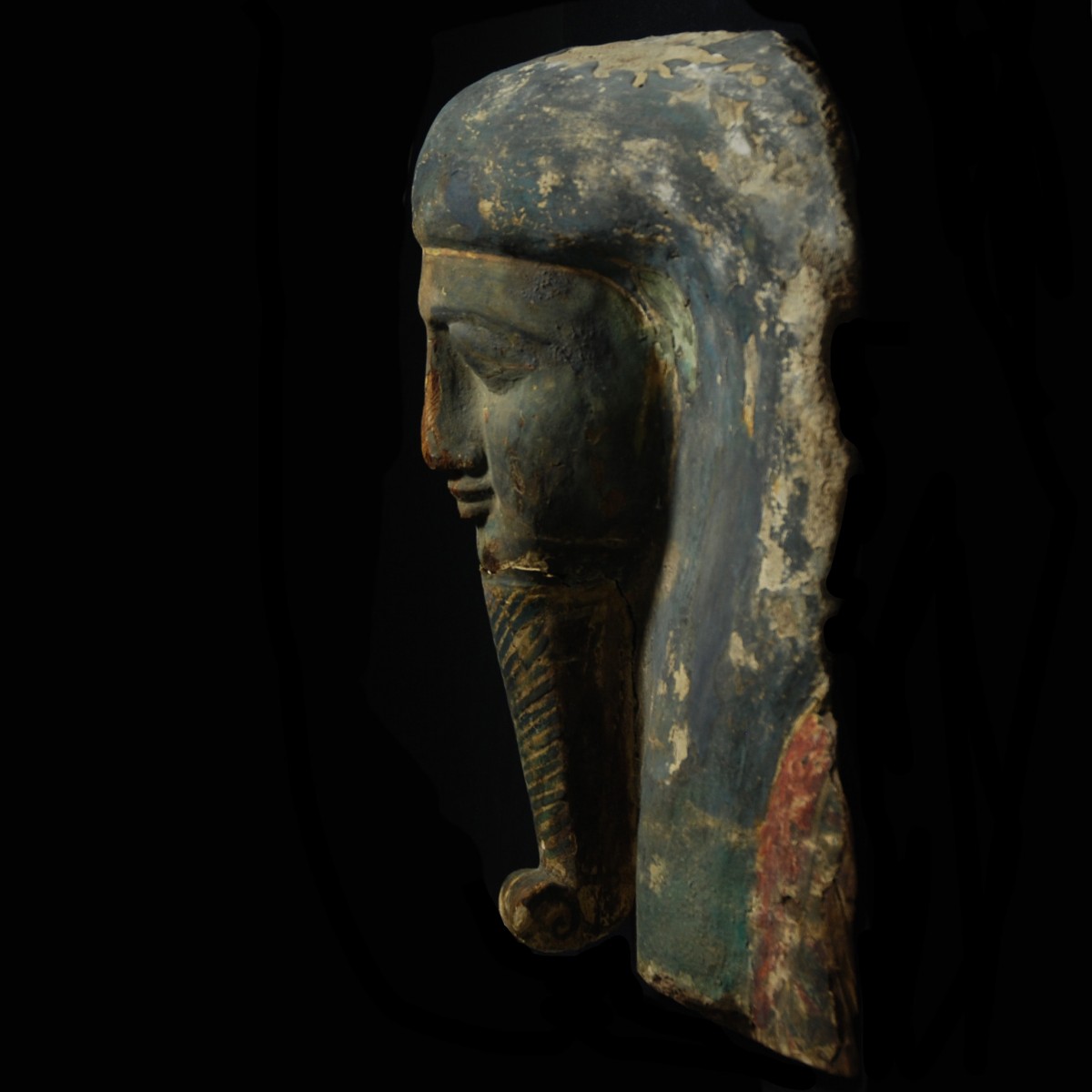
|
|
Egypt – Late Period, 664-332 B.C.
|
Large, very sculptural wood sarcophagus mask depicting a man. The eyes very protruding with a gentle smile and finely drawn brows and lids. On the chin a long, braided beard, with an outwardly curled tip. The heavy wig in large part still preserved. The left ear in green color looking out from the wig. Magnificent mask with intense green, black, blue and red color remains. Mounted on a wood panel covered with black velvet for mounting on the wall.
|
Provenance: Old French private collection, acquired in the 1970s. Originally on a wood panel covered with fabric like in the 1970s.
Dimensions: 44.5 cm high (mask); 50.5 cm x 42 cm (mounting)
Price: 12 000 Euro
|
|
|
|
|
|
|
|
|
|
|
Cyprus – Early 5th century B.C.
|
Finely worked out limestone statuette of a straight standing bearded man with a himation reaching to his feet. His long, curly hair is tied behind his ears by a diadem and falls on his neck. The eyes almond-shaped, the smile with a gentle expression. The right hand is bent in front of the chest, the left is hanging straight down on the side of the body. The archaic face, the himation and the diadem indicate the strong Greek influence to the Cypriot sculpture art of the first half of the 5th century B.C. After the conquest of Cyprus by the Persians in 526-525 BC the relationship of the island to the rich Greek cities of Asia Minor, which were also under Persian rule, deepened. With beautiful color remains. Mounted.
|
Provenance: Gallery Arete, Zurich, Switzerland, prior to 1977. Thence Swiss private collection Dr A. P., Zurich. Since then in a family estate.
Dimensions: 33.5 cm high
Price: 22 000 Euro
|
|
|
|
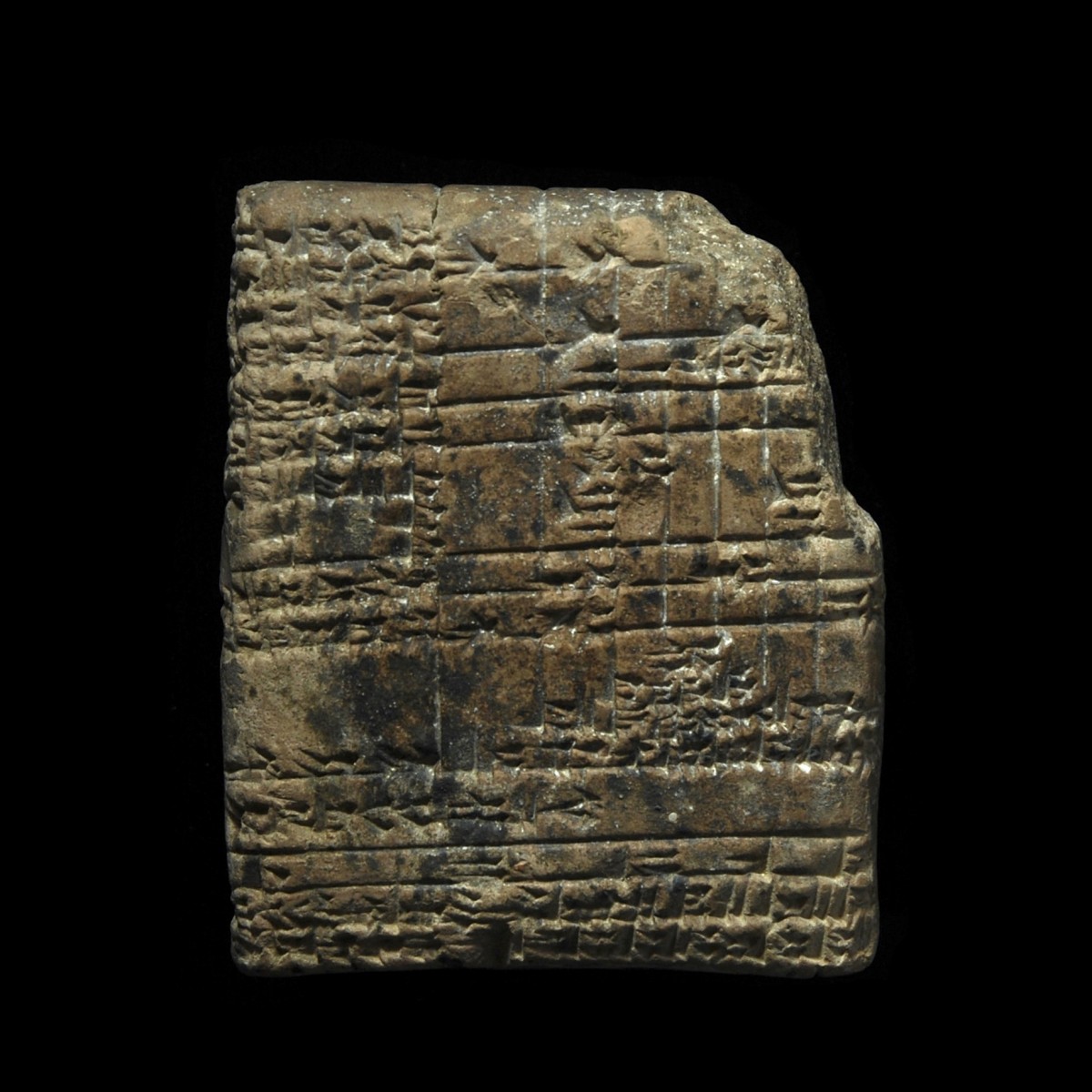
|
|
|
|
|
|
Mesopotamia – 1900-1700 B.C.
|
Large and massive Old Babylonian cuneiform tablet with encircling, finely drawn inscription in grids. It contains an administrative text from the city of Medûm. According to an enclosed old collection note the tablet lists fields close to the canal Zarabushepim in the city of Medûm.
|
Provenance: New York private collection Ira Statfeld, 1980s. Acquired in the 1970s from a private US collection.
Dimensions: 9 cm x 7.5 cm
Price: 1 800 Euro
|
|
|
|
|
|
|
|
|
|
|
Egypt – Ptolemaic Period, 332-30 B.C.
|
Alabaster headrest made of one piece. Under the rounded upper section on each side a high relief of the bearded god Bes with a plumed headdress rising from a lotus blossom, which is worked out also in high relief on the vertical shaft. On each side of the base at the outside engraved depictions of the seated goddess Maat. The upper semicircular upper section was placed right above the ears under the skull. The shaft below should ensure the necessary height. A relatively comfortable sleeping position and the air circulation around the head were guaranteed. In tombs aising the mummy head was associated with resurrection.
|
Provenance: French private collection Pierre, Claude & Jeanine Verité, 1930-1980.
Dimensions: 13.7 cm x 22.6 cm
Price: 8 000 Euro
|
|
|
|
|
|
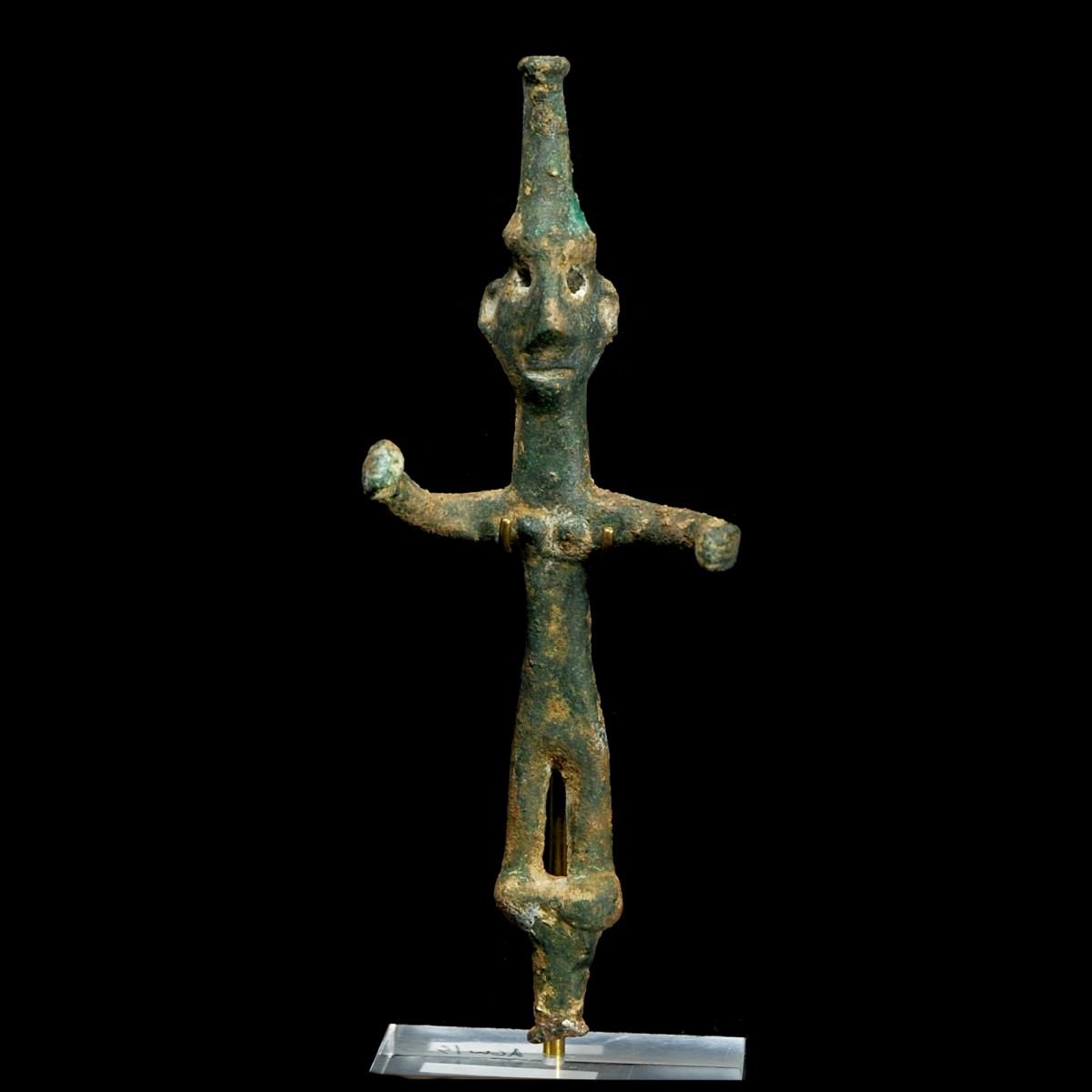
|
Bronze statuette of a Canaanite female deity with a tall conical headdress. The eyes are deeply recessed and possibly once had inlays. Nose and ears are prominent. The body is slender compared to the head, the goddess with small round breasts holds her hands, clenched to fists, in front. They once held her attributes, today lost. The legs are short and straight. Below a tenon which was used to fix the statuette in the temple as a votive offering. Mounted.
|
Provenance: Private collection New York, 1960s. Thence in the collection of Khan family in New Jersey, USA.
Dimensions: 13.8 cm high
Price: 2 800 Euro
|
|
|
|
|
|
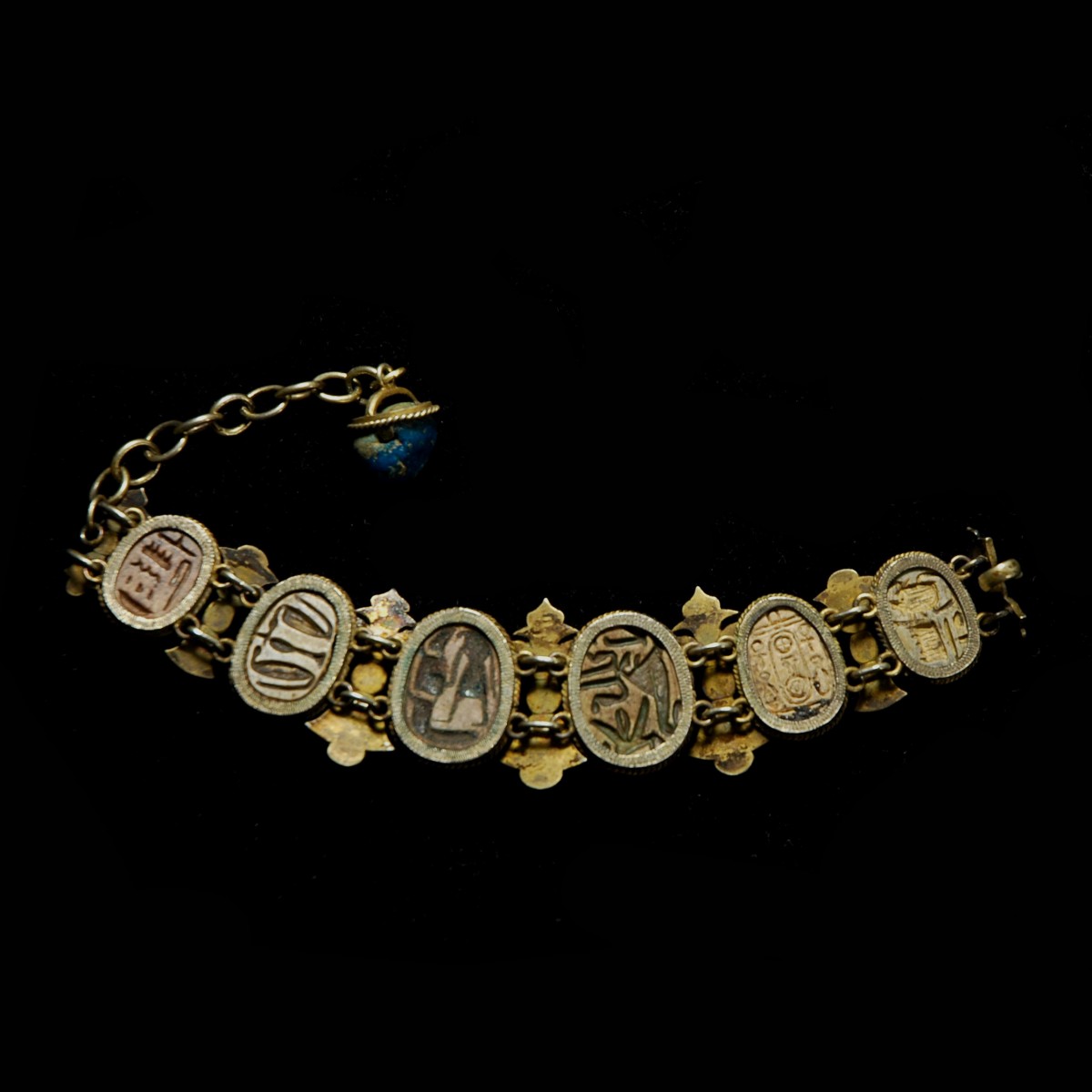
|
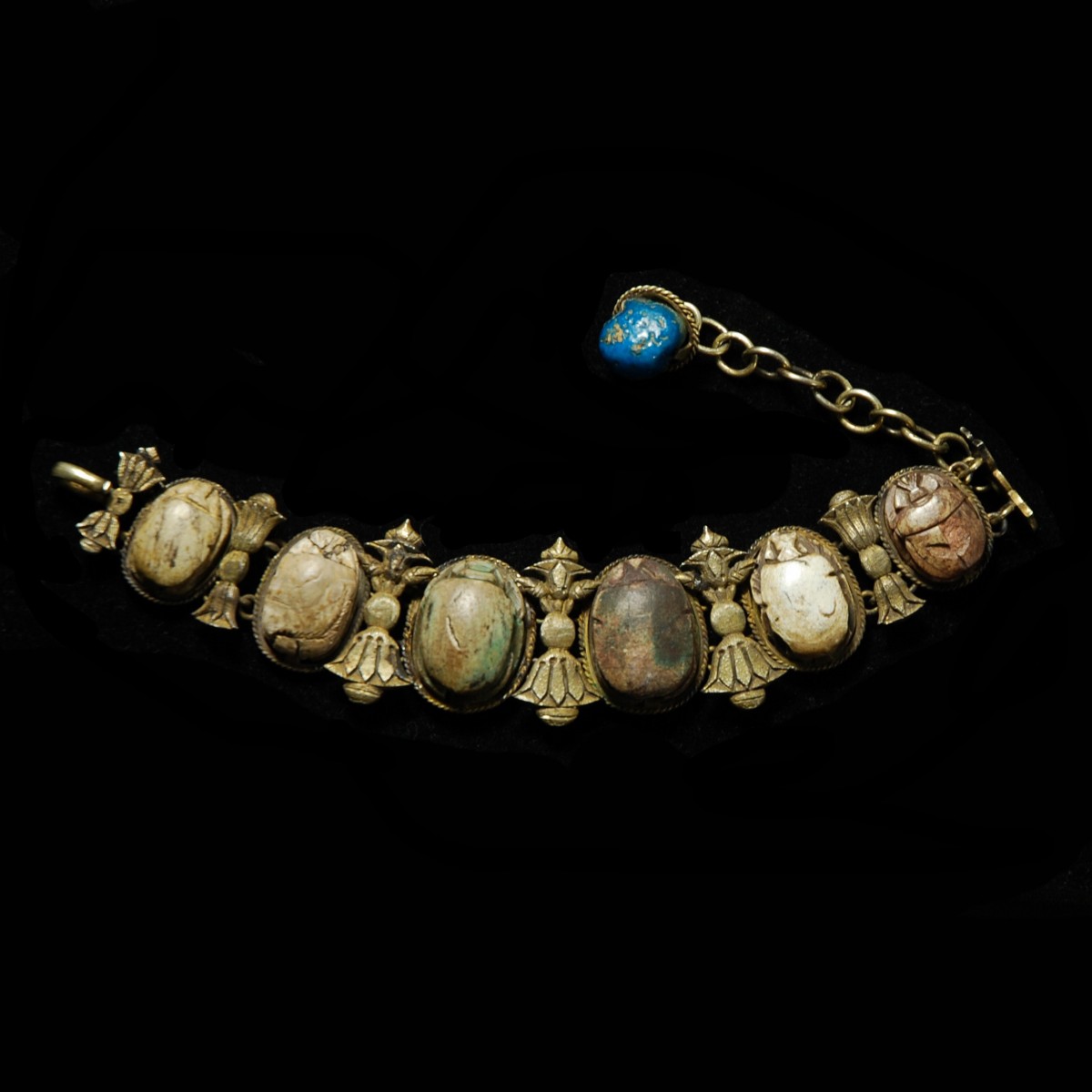
|
|
Egypt – 2nd Intermediate Period, 1648-1550 B.C.
|
Silver bracelet with lotus blossoms from the first half of the 20th century. Between the lotus blossoms in total six steatite scarabs dating to the 2nd Intermediate Period. The scarabs with symbols, inscriptions, one with the depiction of Ra. At the end of the bracelet one set blue faience bead, possibly dating to the 3rd Intermediate Period (1069-664 B.C.). Ready to wear.
|
Provenance: Private collection Yorkshire, Great Britain, acquired mid of the 20th century.
Dimensions: 20.2 cm long
Price: 1 800 Euro
|
|
|
|
|
|
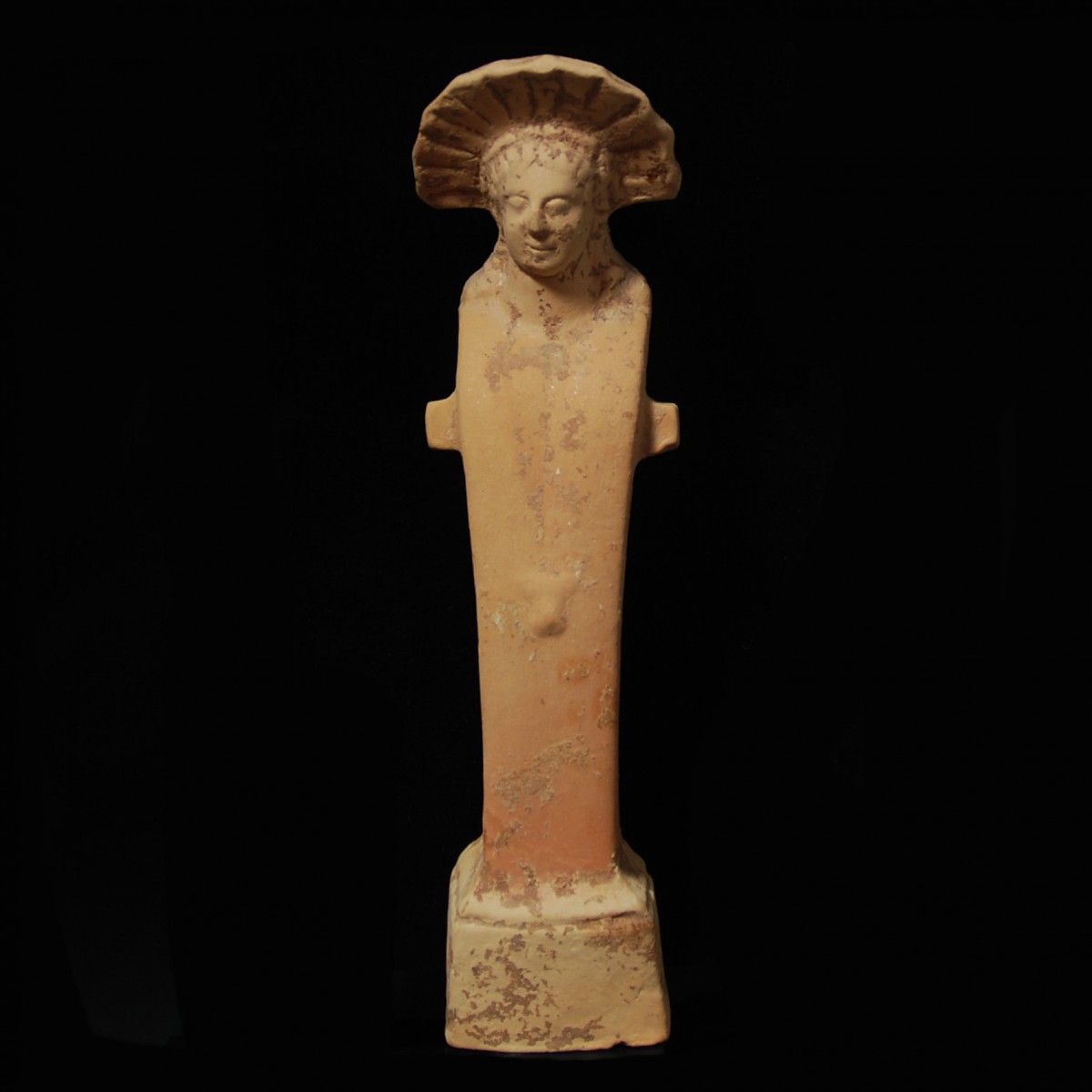
|
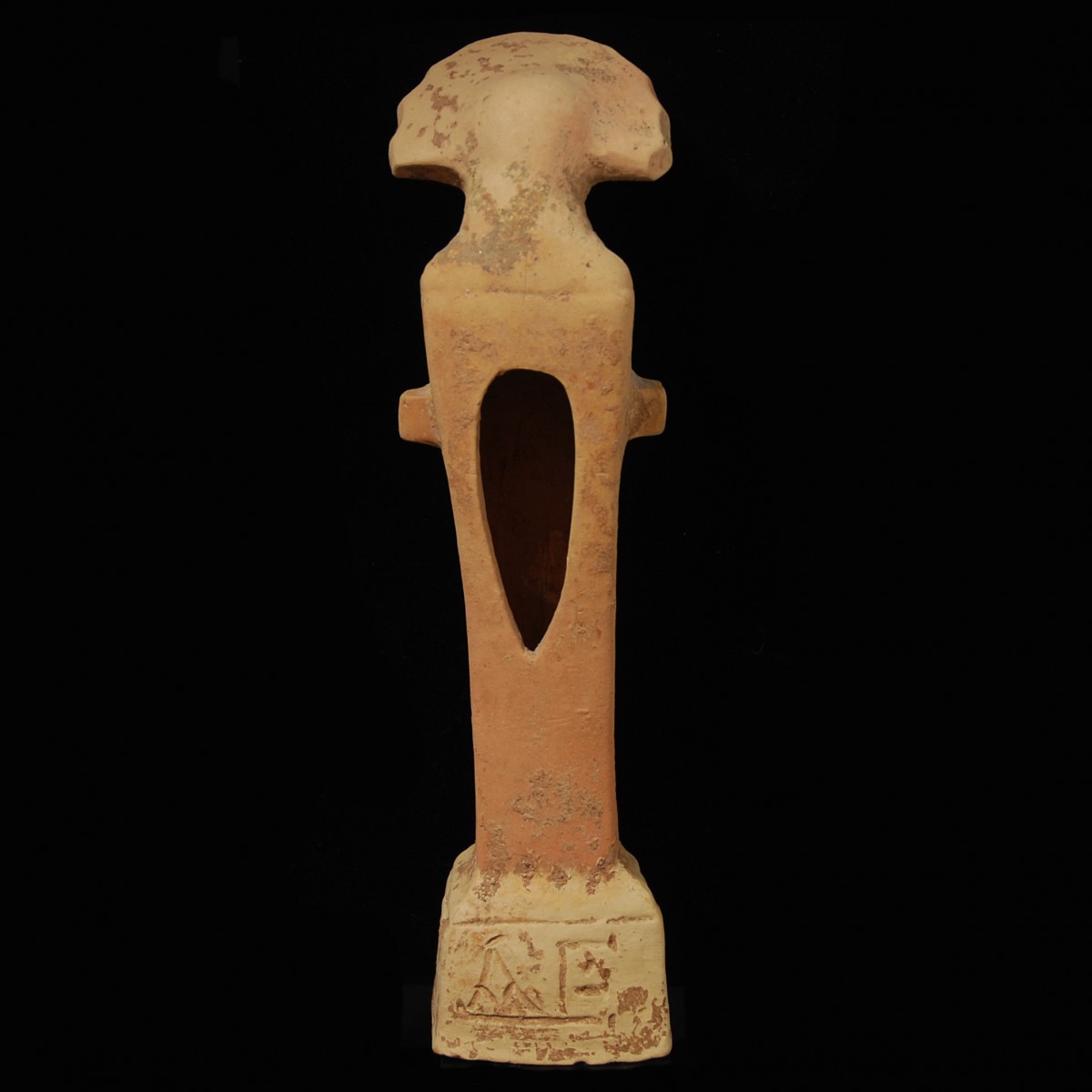
|
|
Greece/South Italy – 4th-3rd century B.C.
|
Terracotta herm on a high base. The bust depicts a male deity with a high radiating segmented crown, underneath the long curly hair cascading over the shoulders. Short wavy strands covering the forehead. Approximately in the middle of the statuette the male genitals in relief. On the back of the base engraved Greek letters as the workshop’s signature. From Southern Italy. Herms like the present one had an apotropaic function, they were placed at crossroads, borders or gates to ward off evil. They were often associated with the god Hermes, protector of merchants and travellers.
|
Provenance: Old Belgian private collection, on the inside the written collection number 15. Thence with André Munter Archeologie, Brussels, Belgium. There acquired on 3 February 2002 by another Belgian private collection. Accompanied by an original certificate from André De Munter, Brussels, Belgium. On the back of the certificate a sticker with the stamp of a court inspection of 26 June 2009 with the signature of the law clerk F. Coene N.
Dimensions: 26.2 cm high
Price: 1 600 Euro
|
|
|
|
|
|
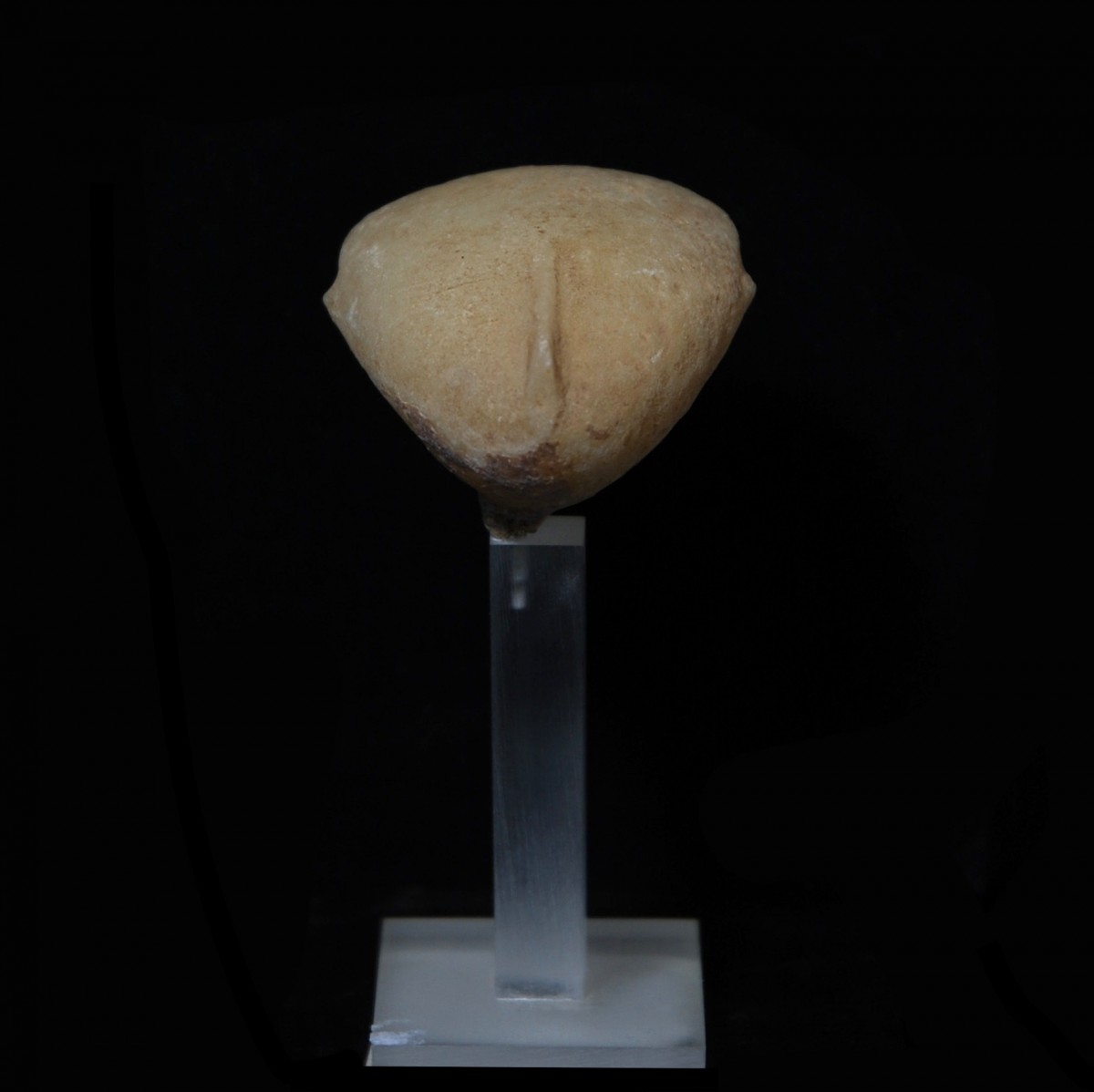
|
|
West Anatolia – 2700-2400 B.C.
|
Very elegantly formed head of a Kiliya- or stargazer idol of white, fine crystalline marble. The broad, forward curved and at the bottom rounded head with a long, slender nose, the back of the head flat. On the sides the ears are protruding. Mounted.
|
Provenance: Swiss private collection, acquired in the 1990s from the gallery Serodine in Ascona.
Dimensions: 2.8 cm x 3.8 cm
Price: 1 600 Euro
|
|
|
|
|
|
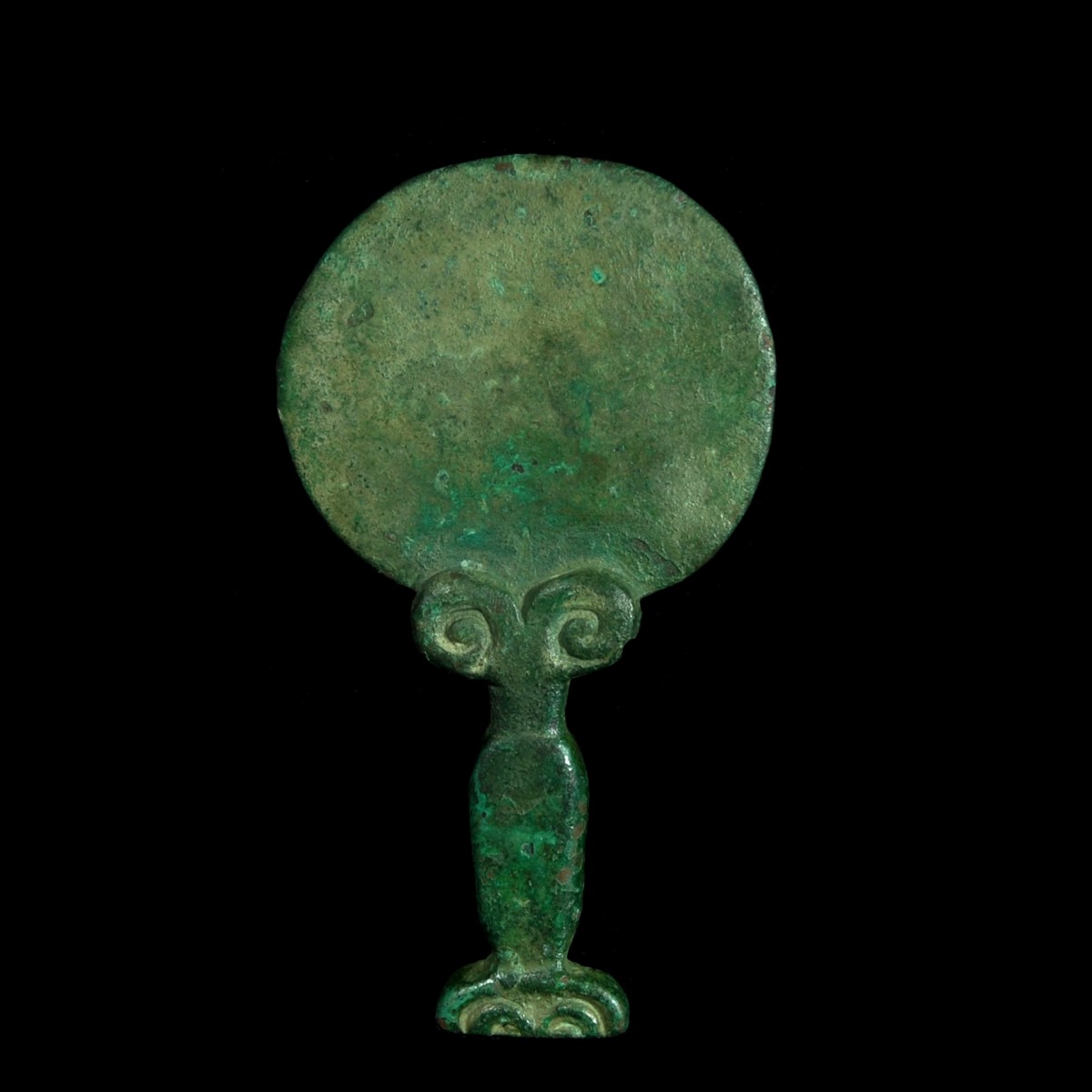
|
|
Eastern Greece/Scythia – 6th-5th century B.C.
|
Small but heavy bronze mirror with a round, massive plate. The handle in form of a vase tapering into two volutes towards the top. The foot rounded with cornices, inside two semicircles.
|
Provenance: South German private collection. Auctioned on 5 November 2014 at Hermann Historica Munich, lot 3776. Thence collection Claus-Eberhard Schultze, Berlin, Germany.
Dimensions: 14.3 cm high
Price: 1 200 Euro
|
|
|
|
|
|
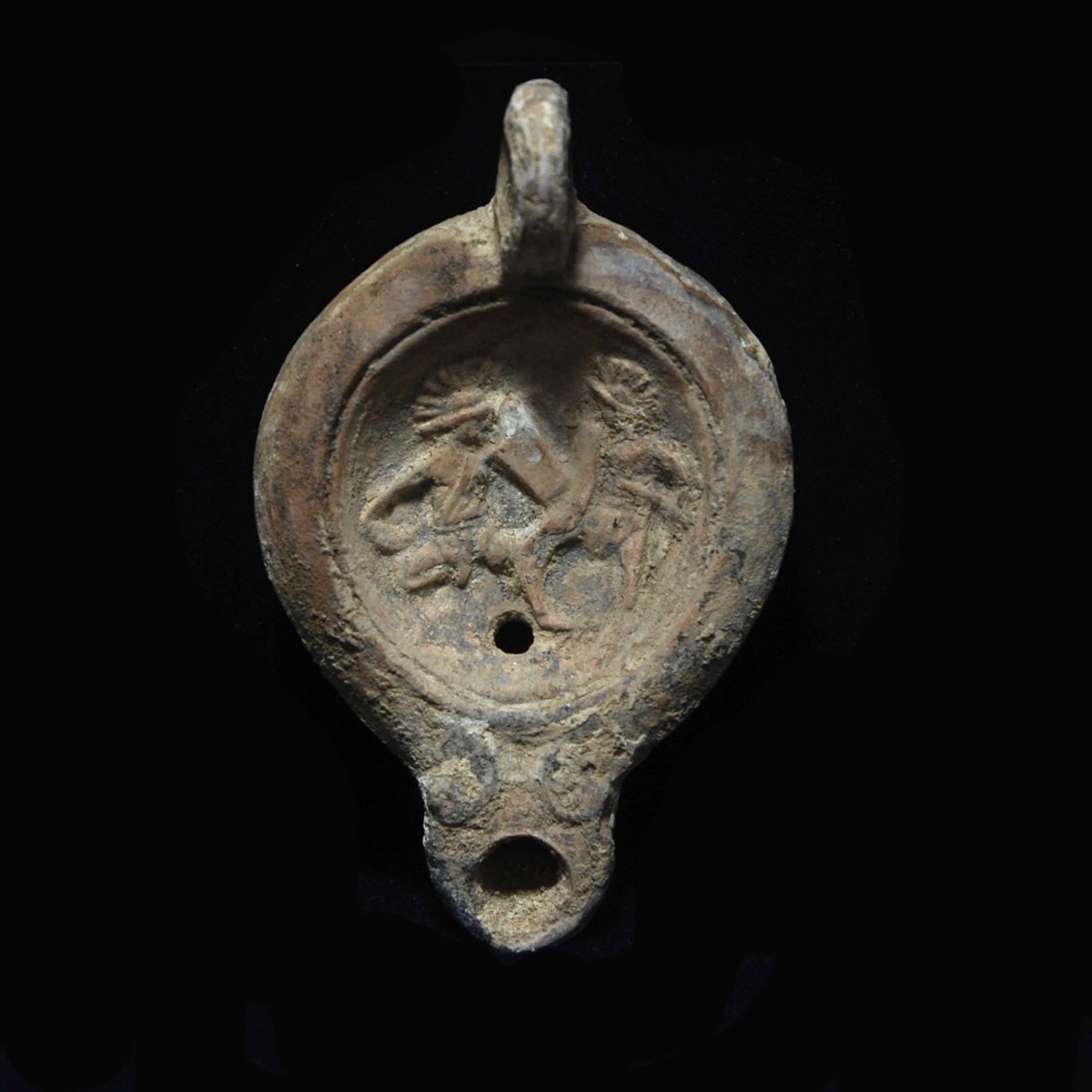
|
|
Roman Empire – 1st century A.D.
|
Terracotta oil lamp with the depiction of a gladiators fight on the discuss. The gladiators, possibly thraex and murmillo, with helmets and high crests, shields and swords. The pouring hole below the scene. The snout with volutes, the handle with a ridge.
|
Provenance: German private collection Claus-Eberhard Schultze, Berlin, Germany.
Dimensions: 10.3 cm long
Price: 500 Euro
|
|
|
|
|
|
|
|
|
Roman Empire – 5th century A.D.
|
Beautifully formed terracotta oil lamp with a long nozzle and a magnificent cross with broadening ends. Above between the horizontal crossbeams rosettes. Below between the beams the two pouring holes. At the intersection of the crossbeams and at the beam ends concentrical circles. On the shoulder abundant relief decoration, amongst them frogs as symbol of resurrection, as well as fish and wine leaves on both sides. Lug handle to the rear with a central rib. A rare form.
|
Provenance: German private collection Claus-Eberhard Schultze, Berlin, Germany.
Dimensions: 10 cm long
Price: 500 Euro
|
|
|
|
|
|
Einladung zur Ausstellung "Faces of the Past" am 18. März in Wien
|
|
Wir freuen uns, Sie am 18. März um 19.00 Uhr zu ersten großen Ausstellung des Jahres in unseren Showroom in Wien einladen zu dürfen. Unter dem Titel "Faces of the Past" zeigen wir über 20 antike Porträts aus Marmor und Terrakotta von berühmten Persönlichkeiten und normalen Menschen der Antike. Porträts, die vor 2000 Jahren einem Schönheitsideal entsprachen und das vielfach noch heute tun.
|
|
Als Vorgeschmack zur Ausstellung präsentieren wir Ihnen in diesem Newsletter die lebensgroße Marmorbüste eines Mädchens mit den Zügen der Fulvia Plautilla, der unglücklichen Gemahlin des Caracalla. Das prachtvolle Porträt zeigt eine junge Frau mit noch kindlichen Pausbacken, jedoch erhabenen Ausdruck und ernsten Zügen. Erstmals zu sehen ist am 18. März auch ein publiziertes Porträt der Agrippina, der Mutter des Nero und Gemahlin des Kaisers Claudius. Ein weiteres Highlight ist nicht zuletzt ein herausragender Frauenkopf aus antoninischer Zeit mit Stilelementen der Crispina, der Frau des Kaisers Commodus.
|
SAVE THE DATE. Bereits diese und die folgende Woche finden Sie uns übrigens auf der WIKAM (von 7. bis 15. März), der ersten großen Wiener Kunstmesse des Jahres. Unser Stand mit über 100 neu erworbenen antiken Kunstwerken ist im Festsaal des prachtvollen Palais Ferstl. Wir feuen uns auf Ihren Besuch!
|
|
|
|
Unser Highlight des Monats:
|
|
Römisches Reich – Severische Zeit, 193-235 n. Chr.
|
Prachtvolles Marmorporträt eines jungen Mädchens, das den bekannten Darstellungen der Fulvia Plautilla, der Frau des späteren Kaisers Caracalla, ähnelt. Das Mädchen mit dem Blick leicht nach rechts gewandt hat große Augen zwischen dicken Lidern, Iris und Pupillen ausgearbeitet. Die Brauen in den Stein gearbeitet. Die Pausbacken noch sehr kindlich, der Ausdruck jedoch schon erhaben, mit geschlossenem Mund und ernsten Zügen. Das Haar in parallelen Strähnen nach hinten gebunden, dabei zahlreiche Details ausgearbeitet. Hinten sind die Haare zu einem flachen Knoten geflochten. Der Hals ist schlank und doch mit sanften Falten versehen. Der Kopf sitzt auf einer kunstvoll gearbeiteten Büste aus dem 17. oder 18. Jahrhundert. Die Brustwarzen waren dabei einst mit Metallstiften versehen, heute sind Marmorstifte angebracht. Die Haarmode, der Mund und die schweren Lider ähneln den zugewiesenen Porträts der Fulvia Plautilla, der Frau des späteren Kaisers Caracalla. Plautilla wurde nach der der Auflösung der Ehe verbannt. Nachdem Caracalla die Herrschaft angetreten hatte, ließ er seine ehemalige Frau ermorden. Vergleiche zum Plautilla-Porträt jenes im Archäologischen Museum Neapel mit der Inventarnummer 6189.
|
Provenienz: Privatsammlung 17.-18. Jahrhundert, basierend auf dem Sockel. Danach in der Privatsammlung eines französischen Komponisten, erworben in den 1940er Jahren. Bonhams Auktion London vom 5. Oktober 2001, Los 137.
Höhe: 60 cm high
Preis: 38.000 Euro
|
|
|
|
Ausgewählte Kunstwerke des Monats:
|
|
Ägypten – Spätzeit, 664-332 v. Chr.
|
Große, sehr plastische Sarkophagmaske aus Holz, die einen Mann darstellt. Die Augen weit hervorstehend mit einem sanften Lächeln und fein gezogenen Brauen und Lidern. Am Kinn ein langer, geflochtener und unten nach vorne eingerollter falscher Bart. Die schwere Perücke noch zu großen Teilen erhalten. Das linke Ohr steht in grüner Farbe noch unter der Perücke hervor. Prachtvolle Maske mit intensiven grünen, schwarzen, blauen und roten Farbresten. Auf einer mit schwarzem Samt bespannten Holzplatte zur Hängung an der Wand montiert.
|
Provenienz: Alte französische Privatsammlung, erworben in den 1970er Jahren. Ursprünglich auf einer mit Stoff bespannten Holzplatte im Geschmack der 1970er Jahre montiert.
Dimensionen: Höhe Maske 44,5 cm; Maße Aufhängung 50,5 cm x 42 cm
Preis: 12.000 Euro
|
|
|
|
|
Zypern – Anfang 5. Jahrhundert v. Chr.
|
Fein gearbeitete Kalksteinstatuette eines aufrecht stehenden bärtigen Mannes im bis zu den Füßen reichenden Himation. Seine langen, gelockten Haare werden durch ein Diadem hinter die Ohren gebunden und fallen ihm in den Nacken. Die Augen mandelförmig, das Lächeln von sanftem Ausdruck. Die rechte Hand ist vor der Brust abgewinkelt, die linke hängt seitlich gerade am Körper herab. Das archaische Gesicht, das Himation und das Diadem weisen auf den starken griechischen Einfluss auf die Bildhauerkunst Zyperns in der ersten Hälfte des 5. Jahrhunderts v. Chr hin. Nach der Eroberung Zyperns durch die Perser 526-525 v. Chr. vertieften sich die Beziehungen der Insel zu den reichen griechischen Städten Kleinasiens, die ebenfalls unter persischer Herrschaft standen. Mit schönen Farbresten. Gesockelt.
|
Provenienz: Galerie Arete, Zürich, vor 1977. Danach Schweizer Privatsammlung Dr. A. P., Zürich. Seitdem in Familienbesitz.
Höhe: 33,5 cm
Preis: 22.000 Euro
|
|
|
|
|
Mespotamien – 1900-1700 v. Chr.
|
Große und massige altbabylonische Keilschrift-Tafel mit umlaufender, fein gezogener Inschrift in Rastern. Es handelt sich um einen administrativen Text aus der Stadt Medûm. Laut einer beiliegenden alten Sammlungsnotiz listet die Tafel Felder nahe dem Kanal Zarabushepim in der Stadt Medûm auf.
|
Provenienz: New Yorker Privatsammlung Ira Statfeld, 1980er Jahre. Erworben in den 1970er Jahren aus einer privaten US-Sammlung.
Dimensionen: 9 cm x 7,5 cm
Preis: 1.800 Euro
|
|
|
|
|
Ägypten – Ptolemäische Zeit, 332-30 v. Chr.
|
Aus einem Stück gefertigte Kopfstütze aus Alabaster. Unter der abgerundeten Auflage jeweils ein Hochrelief des bärtigen Gottes Bes mit Federkrone, der aus einer Lotusblüte erwächst, die am senkrechten Mittelteil ebenfalls im Hochrelief ausgearbeitet ist. Auf der Bodenplatte beidseitig außen jeweils eingravierte Darstellungen der hockenden Göttin Maat. Der halbkreisförmige obere Abschnitt wurde dicht oberhalb des Ohres unter dem Schädel platziert. Die Stütze darunter sollte die erforderliche Höhe garantieren. Das gewährleistete nicht nur eine vergleichsweise bequeme Schlafposition, sondern auch die Luftzirkulation um den Kopf herum. In Gräbern wurde das Hochheben des Mumienkopfes mit Auferstehung assoziiert.
|
Provenienz: Französische Privatsammlung Pierre, Claude & Jeanine Verité, 1930-1980.
Dimensionen: 13,7 cm x 22,6 cm
Preis: 8.000 Euro
|
|
|
|
|
Levante – 1400-1200 v. Chr.
|
Bronze Statuette einer kanaanitischen weiblichen Gottheit mit hoher konischer Kopfbedeckung. Die Augen sind tief gelocht und trugen wohl einst Einlagen. Nase und Ohren sind prominent. Der Körper ist im Vergleich zum Kopf schmächtig, die Göttin mit kleinen runden Brüsten hält die Arme nach vorne. In ihren Fäusten hielt sie heute verlorene Attribute. Die Beine sind kurz und gerade. Unten ein Zapfen mit dem die Statuette im Tempel als Votivgabe fixiert wurde. Gesockelt.
|
Provenienz: Privatsammlung New York, 1960er Jahre. Danach in der Sammlung der Familie Khan in New Jersey, USA.
Höhe: 13,8 cm
Preis: 2.800 Euro
|
|
|
|
|
Ägypten – 2. Zwischenzeit, 1648-1550 v. Chr.
|
Silberarmband mit Lotusblüten aus der 1.Hälfte des 20. Jahrhunderts. Zwischen den Lotusblüten insgesamt sechs Skarabäus aus Steatit, die in die 2. Zwischenzeit datieren. Die Skarabäen mit Symbolen, Inschriften, einer mit einer Darstellung des Ra. Am Ende des Armbands eine gefasste Perle aus blauer Fayence, die wohl in die 3. Zwischenzeit (1069-664 v. Chr.) datiert. Sofort tragbar.
|
Provenienz: Privatsammlung Yorkshire, Großbritannien, erworben Mitte des 20. Jahrhunderts.
Länge: 20,2 cm
Preis: 1.800 Euro
|
|
|
|
|
Griechenland/Süditalien – 4.-3. Jahrhundert v. Chr.
|
Terrakotta-Herme auf hoher Basis. Die Büste zeigt einen männlichen Gott mit hoher Strahlenkrone, unter der das lange lockige Haar seitlich auf die Schultern fällt. Kurze wellige Strähnen bedecken die Stirn. Etwa in der Mitte der Statuette das männliche Geschlecht im Relief. Auf der Rückseite der Basis eingravierte griechische Buchstaben als Werkstatt-Signatur. Aus Süditalien. Hermen wie diese hatten eine apotropäische Funktion, sie wurden an Kreuzungen, Grenzen oder Toren aufgestellt, um das Böse abzuwehren. Häufig sind sie mit dem Gott Hermes in Verbindung gebracht, dem Schutzgott der Kaufleute und Reisenden.
|
Provenienz: Alte belgische Privatsammlung, auf der Innenseite die geschriebene Sammlungsnummer 15. Danach bei André Munter Archeologie, Brüssel. Dort erworben am 3. Februar 2002 von einer anderen belgischen Privatsammlung. Mit Original-Zertifikat von André De Munter, Brüssel. Auf der Rückseite des Zertifikats ein Aufkleber mit Stempel einer Gerichtsbeschau vom 26. Juni 2009 mit der Unterschrift des Gerichtsschreibers F. Coene N.
Höhe: 26,2 cm
Preis: 1.600 Euro
|
|
|
|
|
Westanatolien – 2700-2400 v. Chr.
|
Besonders elegant geformter Kopf eines Kiliya- oder Stargazer-Idols aus weißem, feinkristallinem Marmor. Der breite, nach vorne gewölbte und unten abgerundete Kopf mit langer, dünner Nase, der Hinterkopf flach. Seitlich stehen die kleinen Ohren ab. Gesockelt.
|
Provenienz: Schweizer Privatsammlung, erworben in den 1990er Jahren bei der Galerie Serodine in Ascona.
Dimensionen: 2,8 cm x 3,8 cm
Preis: 1.600 Euro
|
|
|
|
|
Ostgriechenland/Skythien – 6.-5. Jahrhundert v. Chr.
|
Kleiner, aber schwerer Bronze-Spiegel mit runder, massiver Platte. Der Griff in Form einer Vase läuft oben in zwei Voluten aus. Der Fuß abgerundet mit Randleiste, innen zwei Halbkreise.
|
Provenienz: Süddeutsche Privatsammlung. Versteigert am 5. November 2014 bei Hermann Historica München, Los 3776. Danach Sammlung Claus-Eberhard Schultze, Berlin.
Höhe: 14,3 cm
Preis: 1.200 Euro
|
|
|
|
|
Römisches Reich – 1. Jahrhundert n. Chr.
|
Terrakotta-Öllampe mit Darstellung eines Gladiatorenkampfes im Spiegel. Die Gladiatoren, wohl als Thraex und Murmillo zu erkennen, mit Helmen und hohen Helmbuschen, Schildern und Schwertern. Das Einfüllloch unter der Szene. Die Schnauze mit Voluten, der Henkel mit Mittelgrat. Witterungsspuren und Sinter, aber intakt.
|
Provenienz: Deutsche Privatsammlung Claus-Eberhard Schultze, Berlin.
Länge: 10,3 cm
Preis: 500 Euro
|
|
|
|
|
Römisches Reich – 5. Jahrhundert n. Chr.
|
Schön geformte Terrakotta-Öllampe mit langer Schnauze und prächtigem Kreuz mit sich verbreiternden Balkenenden. Oben zwischen den Balken Rosetten. Unten zwischen den Balken die zwei Einfülllöcher. An der Schnittstelle der Kreuzbalken und an den Balkenenden konzentrische Kreise. Auf der Schulter reiches Reliefdekor, darunter Frösche als Zeichen der Auferstehung sowie Fische und Weinblätter, auf beiden Seiten. Der Henkel in Zapfenform mit mittiger Rille. Seltene Form.
|
Provenienz: Deutsche Privatsammlung Claus-Eberhard Schultze, Berlin.
Länge: 10 cm
Preis: 500 Euro
|
|
|
|
|
|
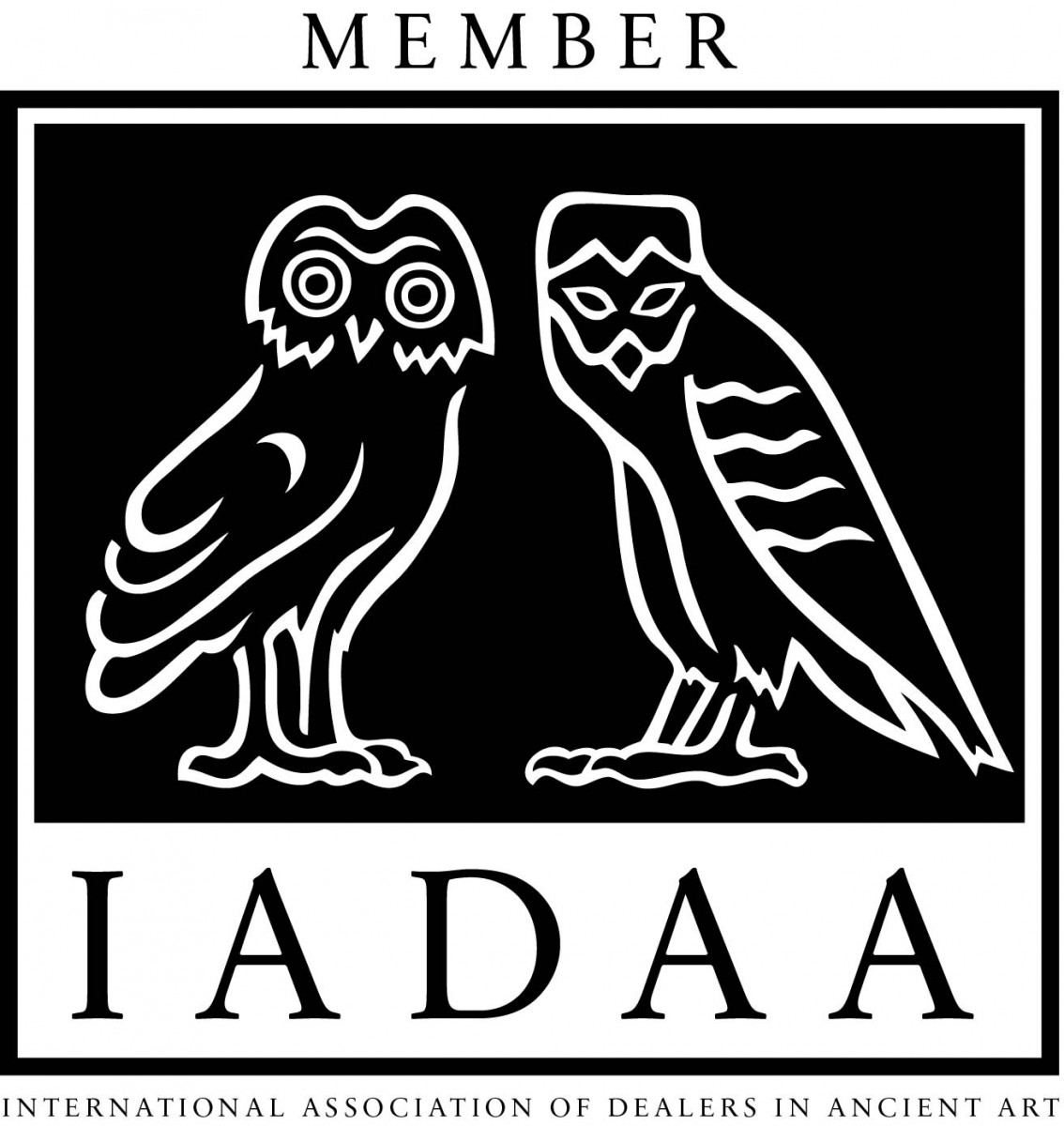
|
|
|
|